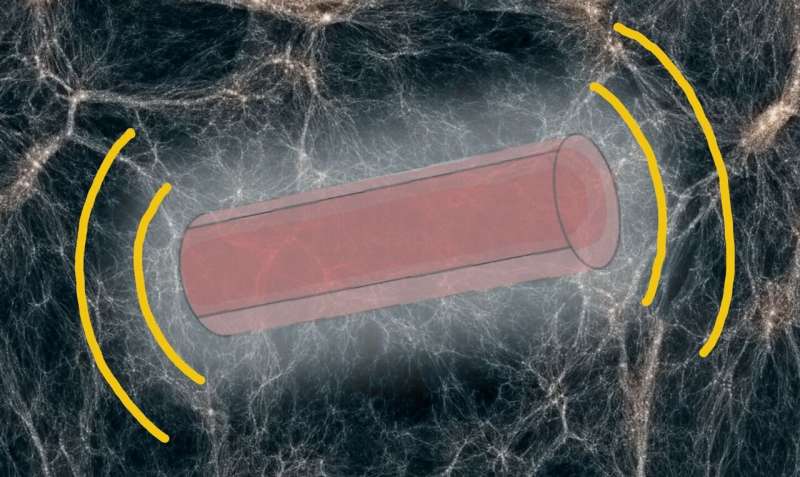Credit: Russell Stump & Swati Singh.
Researchers at University of Delaware, University of Arizona and Haverford College have recently introduced the idea of searching for scalar dark matter using compact acoustic resonators. Their paper, published in Physical Review Letters, theoretically demonstrates the potential of mechanical systems in searching for dark matter.
"As a theorist who started in the field of optomechanics as a graduate student, I have often wondered if it is possible to use some of the exquisite devices that my experimental colleagues are developing as sensors for detecting new physical phenomena," Swati Singh, one of the researchers who carried out the study, told Phys.org. "When I read a paper on how certain types of dark matter can lead to a periodic strain signal, I made the connection to my previous work about detecting gravitational waves from pulsars. The goal of our recent paper was to show the promise of a much wider range of mechanical devices as tabletop sensors of dark matter."
For many years now, theoretical physicists have predicted the existence of particles that do not emit, reflect or absorb light, and thus cannot be detected using traditional tools for the study of matter. While many researchers have tried to detect these particles, known as dark matter, their precise nature remains unknown.
"Although we don't know what dark matter is, we can simplify the search by focusing on theoretically motivated particles," Jack Manley, another researcher involved in the recent study, told Phys.org. "We have chosen to search for 'ultralight' dark matter: particles that are in theory lighter than neutrinos."
Researchers hypothesize that ultralight dark matter is extremely light, lighter even than neutrinos. If such dark matter particles existed, their density would be so large that they would be better viewed as a fluid that permeates the galaxy, producing a wavelike disturbance on normal matter.
"The ultralight dark matter hypothesis is motivated by string-theory scenarios, and moreover, might explain some puzzling discrepancies between the predictions of more prosaic dark molecules and the distribution of dark matter on galactic scales," Daniel Grin, another researcher involved in the study, told Phys.org.
In their study, Singh, Manley, Grin and their colleagues searched for a specific type of particle that causes the sizes of atoms to oscillate, dubbed scalar dark matter. This oscillation would be small for a single atom, yet it may be amplified in objects composed of several atoms. Objects that naturally vibrate in synchrony with this oscillation could amplify the effect even further, resembling a musical instrument.
"A key element of our work is to identify a class of mechanical objects that vibrate at the frequency of ultralight dark matter and produce a very clean resonance," Dalziel Wilson, another researcher who conducted the study, told Phys.org. "We propose to listen to these devices in a very quiet, cryogenic environment, using light as a sort of microphone."
The researchers want to use acoustic compact resonators made of superfluid helium or single crystal materials to search for scalar dark matter candidates. Their theoretical predictions suggest that these resonators could access a broad segment of previously unprobed parameter space.
Overall, the recent study carried out by Singh, Manley, Grin, Wilson and their colleagues highlights the potential of state-of-the-art mechanical systems at the cm-scale for detecting dark matter in previously unexplored regimes, with individual particle masses ranging from 10-48 kg to 10-42 kg. In the future, these resonators could thus play a crucial role in the search for dark matter, particularly that in the ultra-light regime.
"By instigating collaborations between quantum optics and high-energy physics communities (as we did by involving particle physicist Daniel Grin), we can develop a better mutual understanding of the motivation for and limitations of novel detectors for dark matter," Singh said.
Dark photons, particles hypothesized to be mathematically similar to photons, are one of the most popular vector dark matter candidates. While these particles have never been observed before, there is now a substantial amount of theory about them.
In their future studies, the researchers would like to use compact resonators to search for dark photons. Their initial calculations suggest that these mechanical devices could set new bounds on how strongly dark photons would couple to normal matter, but this can only be confirmed by experimental studies.
"We are currently designing an experiment to search for vector dark matter, which couples to the position rather than the size of atoms," Wilson said. "A simple string or drum-like mechanical resonator would be sensitive to this sort of shaking. Interestingly, efforts to measure the quantized motion of cm-scale nanostrings and membranes, in the field of cavity optomechanics, could already set new constraints on the existence of such dark matter."
More information: Jack Manley et al. Searching for Scalar Dark Matter with Compact Mechanical Resonators, Physical Review Letters (2020). DOI: 10.1103/PhysRevLett.124.151301
Journal information: Physical Review Letters
© 2020 Science X Network
























